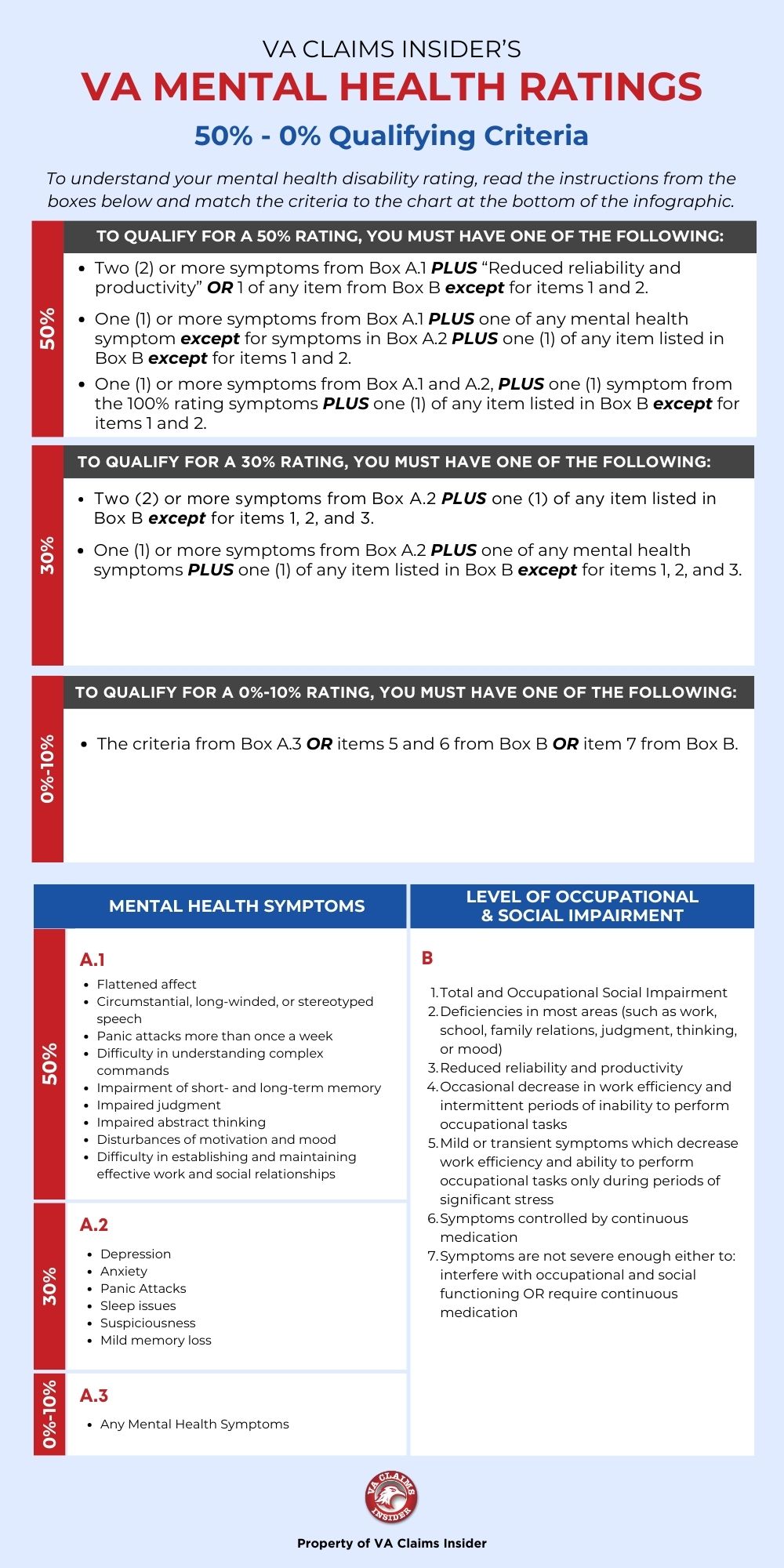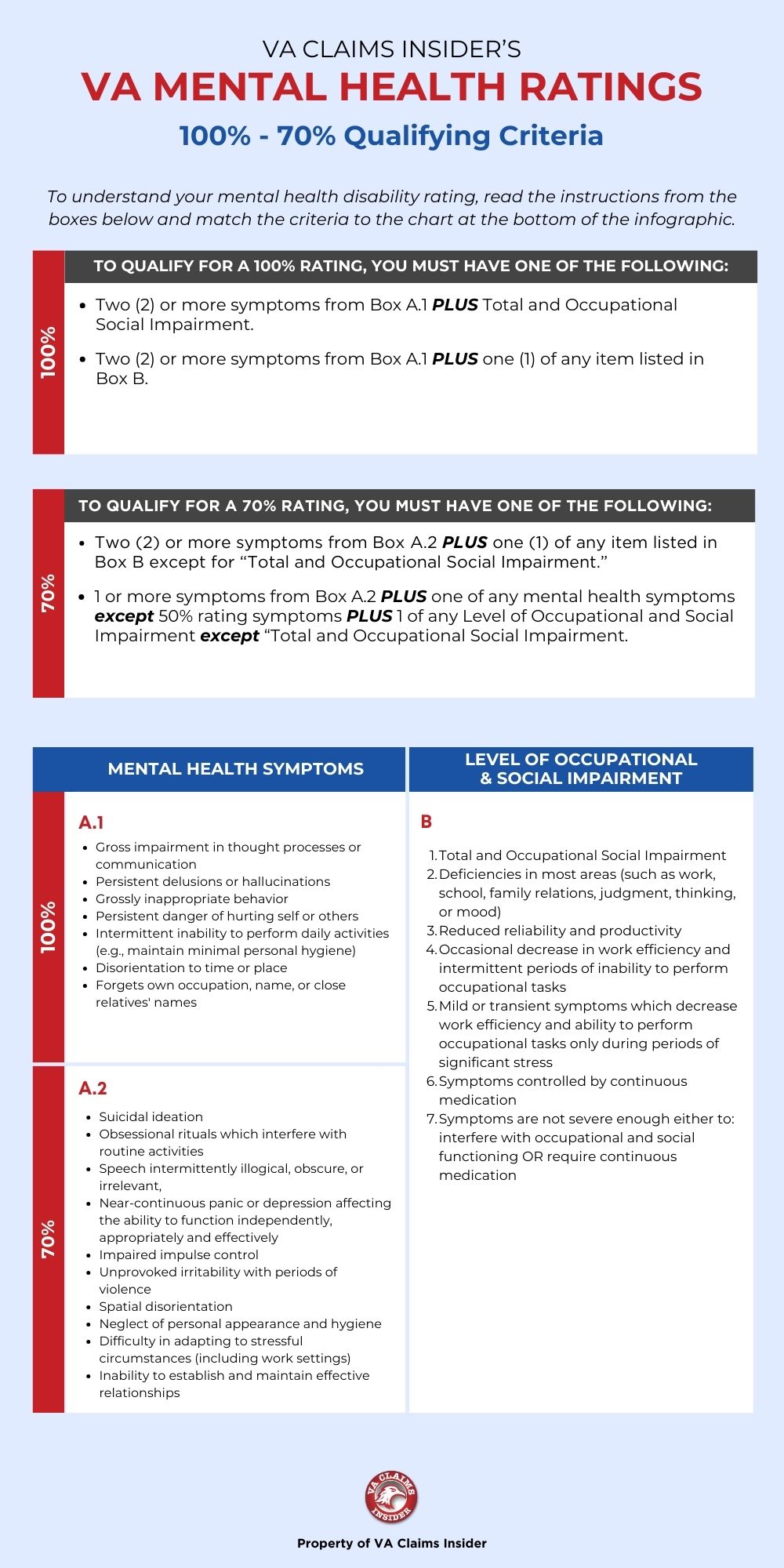Looking for Expert-Level VA Claim Answers?📱Call Us Now! 737-295-2226
The VA currently recognizes 31 mental disorders for rating purposes of the nearly 300 mental health conditions listed in the American Psychiatric Association’s Diagnostic and Statistical Manual of Mental Disorders, Fifth Edition (DSM-5).
According to published VA data, the three most common service connected mental health conditions are post-traumatic stress disorder (56.6%), major depressive disorder (12.6%), and chronic adjustment disorder (7.1%).
In this guide from VA disability expert Brian Reese, you’ll learn about the 31 ratable mental health conditions, the 2025 VA mental health rating chart from 0% to 100%, how the VA Rater determines your final VA rating, and a list of the 31 mental health symptoms recognized by the VA.
Let’s begin!
Table of Contents
Summary of Key Points
- The VA recognizes 31 mental disorders for rating purposes out of nearly 300 listed in the DSM-5, focusing on the most common conditions that impact military veterans.
- The three most common service-connected mental health conditions among veterans are post-traumatic stress disorder, major depressive disorder, and chronic adjustment disorder.
- The VA uses the General Rating Formula for Mental Disorders from 38 CFR § 4.130 to rate mental health conditions from 0% to 100% with breaks at 10%, 30%, 50%, and 70%.
- Your final VA rating for mental health depends on the frequency, severity, and duration of your symptoms, as well as how these symptoms negatively impact your occupational and social impairment.
31 Mental Health Conditions Rated By the VA
Here’s the list of the 31 mental health conditions and their appropriate Diagnostics Code (DC) that can be rated by the VA:
- DC 9201, Schizophrenia
- DC 9208, Delusional disorder
- DC 9210, Other specified and unspecified schizophrenia spectrum and other psychotic disorders
- DC 9211, Schizoaffective disorder
- DC 9300, Delirium
- DC 9301, Major or mild neurocognitive disorder due to HIV or other infections
- DC 9304, Major or mild neurocognitive disorder due to traumatic brain injury
- DC 9305, Major or mild vascular neurocognitive disorder
- DC 9310, Unspecified neurocognitive disorder
- DC 9312, Major or mild neurocognitive disorder due to Alzheimer’s disease
- DC 9326, Major or mild neurocognitive disorder due to another medical condition or substance/medication-induced major or mild neurocognitive disorder
- DC 9400, Generalized anxiety disorder
- DC 9403, Specific phobia; social anxiety disorder (social phobia)
- DC 9404, Obsessive compulsive disorder
- DC 9410, Other specified anxiety disorder
- DC 9411, Post-traumatic stress disorder
- DC 9412, Panic disorder and/or agoraphobia
- DC 9413, Unspecified anxiety disorder
- DC 9416, Dissociative amnesia; dissociative identity disorder
- DC 9417, Depersonalization/Derealization disorder
- DC 9421, Somatic symptom disorder
- DC 9422, Other specified somatic symptom and related disorder
- DC 9423, Unspecified somatic symptom and related disorder
- DC 9424, Conversion disorder (functional neurological symptom disorder)
- DC 9425, Illness anxiety disorder
- DC 9431, Cyclothymic disorder
- DC 9432, Bipolar disorder
- DC 9433, Persistent depressive disorder (dysthymia)
- DC 9434, Major depressive disorder
- DC 9435, Unspecified depressive disorder
- DC 9440, Chronic adjustment disorder
2025 VA Mental Health Rating Chart
The VA uses the General Rating Formula for Mental Disorders from 38 CFR § 4.130 to rate mental health conditions from 0% to 100% with breaks at 10%, 30%, 50%, and 70%.
| Level of Occupational and Social Impairment and Approximate Severity of Symptoms | VA Rating | Minimum Monthly Payment |
|---|---|---|
| Total occupational and social impairment, due to such symptoms as: gross impairment in thought processes or communication; persistent delusions or hallucinations; grossly inappropriate behavior; persistent danger of hurting self or others; intermittent inability to perform activities of daily living (including maintenance of minimal personal hygiene); disorientation to time or place; memory loss for names of close relatives, own occupation, or own name. | 100% | $3,831.30 |
| Occupational and social impairment, with deficiencies in most areas, such as work, school, family relations, judgment, thinking, or mood, due to such symptoms as: suicidal ideation; obsessional rituals which interfere with routine activities; speech intermittently illogical, obscure, or irrelevant; near-continuous panic or depression affecting the ability to function independently, appropriately and effectively; impaired impulse control (such as unprovoked irritability with periods of violence); spatial disorientation; neglect of personal appearance and hygiene; difficulty in adapting to stressful circumstances (including work or a worklike setting); inability to establish and maintain effective relationships. | 70% | $1,759.19 |
| Occupational and social impairment with reduced reliability and productivity due to such symptoms as: flattened affect; circumstantial, circumlocutory, or stereotyped speech; panic attacks more than once a week; difficulty in understanding complex commands; impairment of short- and long-term memory (e.g., retention of only highly learned material, forgetting to complete tasks); impaired judgment; impaired abstract thinking; disturbances of motivation and mood; difficulty in establishing and maintaining effective work and social relationships. | 50% | $1,102.04 |
| Occupational and social impairment with occasional decrease in work efficiency and intermittent periods of inability to perform occupational tasks (although generally functioning satisfactorily, with routine behavior, self-care, and conversation normal), due to such symptoms as: depressed mood, anxiety, suspiciousness, panic attacks (weekly or less often), chronic sleep impairment, mild memory loss (such as forgetting names, directions, recent events). | 30% | $537.42 |
| Occupational and social impairment due to mild or transient symptoms which decrease work efficiency and ability to perform occupational tasks only during periods of significant stress, or symptoms controlled by continuous medication. | 10% | $175.51 |
| A mental condition has been formally diagnosed, but symptoms are not severe enough either to interfere with occupational and social functioning or to require continuous medication. | 0% | Non-Compensable |
How the VA Rater Determines Your Final Mental Health Rating
The VA Rater uses a three-part test from an online Eval Builder Tool to determine your final VA rating for mental health:
- First, there’s a subjective assessment of symptoms from the list of 31 VA mental health symptoms. Your mental health symptoms can come from the medical evidence submitted with your claim as well as the results of your C&P exam for mental health.
- Second, there’s a subjective assessment of how those symptoms impact your occupational and social impairment, meaning your work, life, and social functioning. This also comes from your submitted medical evidence and the results of your C&P exam.
- Finally, the online tool lists your approximate mental health rating at 0%, 10%, 30%, 50%, 70%, or 100%; however, the VA Rater has the ability to override it and go one rating level above or one rating level below the recommended disability percentage.
VA Mental Health Rating Criteria: 0% to 50%

VA Mental Health Rating Criteria: 70% to 100%

31 VA Mental Health Symptoms for Rating Purposes
Here’s a list of the 31 mental health symptoms recognized by the VA along with a detailed explanation of each symptom from the Disability Benefits Questionnaire for Mental Disorders:
- Depressed Mood: A persistent feeling of sadness or a lack of interest in external stimuli, which might manifest as a significant decrease in the person’s overall mood.
- Anxiety: Frequent or constant feelings of worry, nervousness, or unease about something with an uncertain outcome or about general aspects of daily life.
- Suspiciousness: An irrational or excessive distrust of others, which can lead to significant social dysfunction and isolation.
- Panic Attacks (weekly or less often): Sudden onset of intense fear or discomfort that peaks within minutes, including symptoms such as palpitations, sweating, shaking, shortness of breath, and feelings of impending doom, occurring infrequently.
- Panic Attacks (more than once a week): Similar to the above but occurring with a greater frequency, which can significantly disrupt daily functioning.
- Near-continuous Panic or Depression: These conditions significantly impair one’s ability to function independently, appropriately, and effectively due to their constant presence.
- Chronic Sleep Impairment: Ongoing difficulties in falling or staying asleep, which affects daily functioning and overall health.
- Mild Memory Loss: Includes forgetting names, directions, or recent events, which can affect daily functioning but might not necessarily impede professional responsibilities or personal relationships significantly.
- Impairment of Short and Long Term Memory: This is more severe than mild memory loss and includes difficulty retaining new information or recalling previously known information.
- Memory Loss for Names of Close Relatives, Own Occupation, or Own Name: A severe level of memory loss, impacting the individual’s ability to recall significant, well-established information about their life.
- Flattened Affect: A lack of emotional expressiveness, where the person shows minimal emotional reactions to various circumstances.
- Circumstantial, Circumlocutory, or Stereotyped Speech: Speech that is indirect and delayed in reaching the point, often because of unnecessary detail or inappropriate repetition of phrases.
- Speech Intermittently Illogical, Obscure, or Irrelevant: Speech that may not follow logical patterns, contains unclear expressions, or is tangentially related to the conversation’s context.
- Difficulty in Understanding Complex Commands: Challenges in comprehending and processing multifaceted and layered instructions.
- Impaired Judgment: Reduced ability to make thoughtful decisions, which might include an inability to understand the consequences of one’s actions.
- Impaired Abstract Thinking: Difficulty in understanding abstract concepts and using those concepts to problem-solve effectively.
- Gross Impairment in Thought Processes or Communication: Significant disruptions in the ability to think clearly or communicate effectively.
- Disturbances of Motivation and Mood: Variability or changes in mood and motivation that interfere with daily life.
- Difficulty in Establishing and Maintaining Effective Work and Social Relationships: Problems with forming and sustaining relationships in both personal and professional contexts.
- Difficulty Adapting to Stressful Circumstances: Challenges with adjusting to stressful situations typically manageable by average persons.
- Inability to Establish and Maintain Effective Relationships: More severe difficulties with social relationships, where maintaining any form of consistent interaction is problematic.
- Suicidal Ideation: Thoughts about taking one’s own life, which may range from vague ideas to detailed planning.
- Obsessional Rituals Which Interfere with Routine Activities: Repetitive behaviors or thoughts that are intrusive and interfere with normal routines and activities.
- Impaired Impulse Control: Difficulty controlling impulses which can manifest as episodes of unprovoked irritability or violence.
- Spatial Disorientation: Trouble understanding and remembering the layout of places, leading to confusion about one’s location.
- Persistent Delusions or Hallucinations: Ongoing false beliefs or perceptions in the absence of external stimuli, which may affect behavior and interaction.
- Grossly Inappropriate Behavior: Actions that are dramatically out of context and inappropriate for the situation or social norms.
- Persistent Danger of Hurting Self or Others: Ongoing risk of causing harm to oneself or others, possibly requiring intervention to prevent such outcomes.
- Neglect of Personal Appearance and Hygiene: Significant lack of concern about personal grooming and cleanliness, which is noticeable by others.
- Intermittent Inability to Perform Activities of Daily Living: Periodic failures to manage everyday tasks independently, such as bathing, dressing, or feeding oneself.
- Disorientation to Time or Place: Confusion about the current time or location, which can lead to difficulties navigating daily life.
About the Author

Brian Reese
Brian Reese is a world-renowned VA disability benefits expert and the #1 bestselling author of VA Claim Secrets and You Deserve It. Motivated by his own frustration with the VA claim process, Brian founded VA Claims Insider to help disabled veterans secure their VA disability compensation faster, regardless of their past struggles with the VA. Since 2013, he has positively impacted the lives of over 10 million military, veterans, and their families.
A former active-duty Air Force officer, Brian has extensive experience leading diverse teams in challenging international environments, including a combat tour in Afghanistan in 2011 supporting Operation ENDURING FREEDOM.
Brian is a Distinguished Graduate of Management from the United States Air Force Academy and earned his MBA from Oklahoma State University’s Spears School of Business, where he was a National Honor Scholar, ranking in the top 1% of his class.



